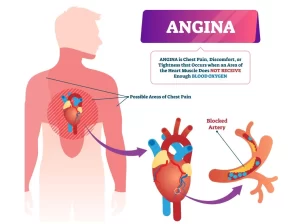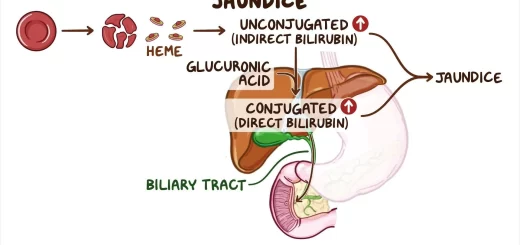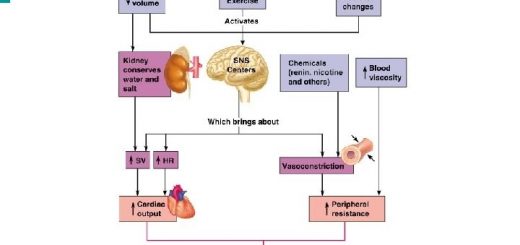Angina causes, symptoms, types, Is angina dangerous and what is the best treatment for angina?
Angina is the most common presenting symptom of coronary artery disease, occurring in 80% of the elderly. It is a clinical syndrome of chest pain due to an imbalance between the oxygen supply and demands of the myocardium.
Angina
Angina refers to chest pain or discomfort that occurs when the heart muscle doesn’t get enough oxygen-rich blood. It often feels like pressure, squeezing, or tightness in the chest, though it can also present as discomfort in the shoulders, arms, neck, jaw, or back. Angina is typically a symptom of an underlying heart problem, usually coronary artery disease (CAD), which is caused by the narrowing or blockage of the coronary arteries due to atherosclerosis.
Causes of Angina
Decreased myocardial oxygen supply:
Decrease in quantity:
a) Coronary artery disease:
- Atherosclerosis. (most common cause).
- Arteritis: polyarteritis nodosa, SLE.
- Coronary spasm.
- Coronary embolism.
b) As a part of LCOP: AS, LSHF.
Decrease in quality: Anemia, and Hypoxia.
Increased myocardial oxygen demand
- Ventricular hypertrophy.
- Tachycardia.
Types of Angina
Stable Angina
- Triggered by physical activity or stress.
- Predictable and lasts a short time (usually 5 minutes or less).
- Relieved by rest or nitroglycerin.
Unstable Angina
- Occurs at rest or with minimal exertion.
- Unpredictable and more severe.
- Not always relieved by rest or medication.
- A medical emergency, as it can signal an impending heart attack.
Variant (Prinzmetal’s) Angina
- It is caused by a spasm in the coronary arteries.
- Often occurs at rest, typically at night or early morning.
- Can be severe, but usually relieved by medication.
Microvascular Angina
Affects the heart’s smallest coronary arteries.
It can be more severe and last longer than other types of angina.
May not be relieved by typical angina medications.
Diagnosis and Treatment
Diagnosis of angina may involve tests like an electrocardiogram (ECG), stress testing, blood tests, coronary angiography, or imaging studies. Treatment typically includes lifestyle changes, medications, and, in some cases, procedures like angioplasty or coronary artery bypass surgery.
Medications may include
- Nitrates (e.g., nitroglycerin).
- Beta-blockers.
- Calcium channel blockers.
- Aspirin.
- Statins.
- Antiplatelet drugs.
Lifestyle changes include
- Eating a heart-healthy diet.
- Exercising regularly.
- Quitting smoking.
- Managing stress.
- Controlling blood pressure, cholesterol, and diabetes.
Symptoms of Angina
- Chest pain or discomfort.
- There is pain in the arms, neck, jaw, shoulder, or back.
- Nausea.
- Fatigue.
- Shortness of breath.
- Sweating.
- Dizziness.
A history of classic exertional angina may be difficult to obtain as the elderly patient who has limited activity and do not develop symptoms until late in the course of the disease. Dyspnea on exertion is a very common manifestation of coronary disease in the elderly.
Other symptoms
- Palpitation,
- Weakness, dizziness.
- Unexplained diaphoresis.
- Indigestion.
- Dyspnea.
Signs: during the attack
- S1: Faint heart sounds.
- S2: Reversed splitting of dt LBBB.
- S3: due to LVF.
- S4: reduced left ventricular compliance.
- Murmur: Transient Mitral regurge (papillary muscle dysfunction).
Investigations
ECG
Resting ECG:
- In between the attacks: usually normal.
- During the attack: ST segment: depressed. (More than 2mm in > 1 lead), T wave Inverted.
Exercise ECG: (in between the attacks only)
- Dobutamine (to make the heart excitable)
- The stress test is considered +ve when: one or more of these changes are present.
- Symptom: Typical anginal pain during the test.
- Sign: A fall in blood pressure (10 mmHg or more) suggests ischemia.
- ECG: Depressed ST segment > 2mm.
Thallium Scintigraphy
(Radioactive Thallium 201) Thallium 201: is taken up by healthy myocardium & not by ischemic myocardium (cold spot)
Coronary angiography
- Generally used to determine whether mechanical revascularization (CABG or PTCA) is possible & to guide this therapy.
- Remains the definitive test for the diagnosis of coronary artery disease.
Cardiac enzymes
Normal
Treatment
Non-medical Treatment
Correct any precipitating t factors:
- increased physical activity.
- weight management (optimal mass index 24) glycemic control.
- Blood. pressure control.
- LDL cholesterol-lowering therapy (statin, fibrates and nicotinic acid).
Medical treatment
During an attack: nitrates Sublingual NG isosorbide dinitrate. If the patient is not relieved after the use of 2-3 tablets, the patient should be immediately transferred to the hospital & evaluated for the possibility of myocardial infarction.
In between attacks
- Nitrates: Venodilator (Coronary dilatation): Oral NG (nitromak), Isosodinitrate (dinitra), Side effects: Orthostatic, hypotension, headache, syncope.
- Beta-blockers: Reduce heart works: Bisoprolo (concor), Propnalol (indral), carvidolol (cardilol), contraindicated in vasospastic angina), Side effects: Fatigue, depression, bradycardia, heart block, hypotension.
- Anti platelets: Aspirin Clopidogril (Plavix).
- CCB (Calcium channel blockers): -ve inotropic Arteriolar dilatation, More effective in coronary dilation (used in variant).
Interventionalatoni
- (PTCA) (trans-luminal coronary Angioplasty), Stenosis of one or two vessels only (except left main coronary artery).
- CABG (Coronary Artery Bypass Graft in left main vessel disease, 2 or 3 vessels disease.
You can follow science online on YouTube from this link: Science online
You can download Science Online application on Google Play from this link: Science online Apps on Google Play
Properties of cardiac muscles, Cardiac automaticity and Conduction of electrical impulses
Histology of the heart, Cardiomyocyte types, Ultrastructure and features of cardiac muscle fibers
Mediastinum contents, Aorta parts, Brachiocephalic trunk, Pulmonary trunk and Thoracic duct trunk
Electrocardiogram (ECG) importance, ECG test results, analysis and abnormalities
Heart & Pericardium structure, Abnormalities and Development of the heart
Heart function, structure, Valves, Borders, Chambers and Surfaces
Cardiac Markers review, definition, list, test, and myoglobin function




